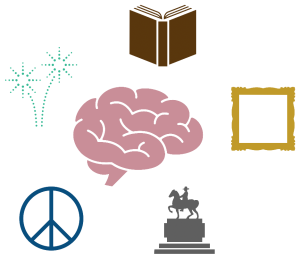cultural memory
 Assmann and Assmann define cultural memory from a cultural studies perspective as „tradition within us, […] the texts, images, and rites that have been hardened over generations, in centuries, even in some cases millennia of repetition, and that shape our consciousness of time and history, our view of ourselves and the world.“ (Assmann, J. 2006, 70)
Assmann and Assmann define cultural memory from a cultural studies perspective as „tradition within us, […] the texts, images, and rites that have been hardened over generations, in centuries, even in some cases millennia of repetition, and that shape our consciousness of time and history, our view of ourselves and the world.“ (Assmann, J. 2006, 70)
The triad of memory
The term, which is mainly used in the memory discourses of cultural studies, is part of a conceptual triad which, according to Aleida Assmann, describes fundamentally different forms of memory:
– the individual memory
– the (social) communicative memory
– the cultural memory (cf. Assmann, A. 2006, 13)
Forms of memory
While the individual memory of a person is filled with implicit as well as explicit, i.e. autobiographical memories, memories are also preserved through interaction with others in the collective memory, i.e. in the family, in a social group or in the society as a whole. Communicative, or oral, traditions are passed down from generation to generation.
The French sociologist Maurice Halbwachs describes the relationship between individual memories and society as follows: „Most of the time I remember because others drive me to it, because their memory comes to the aid of mine, because mine draws on theirs. At least in these cases, there is nothing mysterious about memory“ (Halbwachs 1966, 20 f.).
However, „our memories are not only social, but also culturally <<embedded>>“ (Assmann, J. 2006, 69). Texts, images, things, symbols and rites form the cultural memory and are the basis of our cultural identity. Carriers of these cultural traditions are „extern[e] storage media and cultur[e] practices“ (Assmann, A. 2006, 19) that preserve language, images, voices, and sounds. For „only storage sites and media turn a communicative memory into a truly cultural memory.“ (Reichwein 2018)
History and identity
But how is it determined what we remember and what we forget? AfD circles call for a „180-degree turn in memory policy“ and marginalize the Holocaust as a „bird’s nest.“ The so-called „guilt cult“ of the Germans is denounced and thus cultural memory is increasingly called into question.
It becomes clear that cultural memory is not static. It is subject to dynamics and changes that must be discussed and negotiated by society as a whole. After all, „what is remembered and what is forgotten is to a large extent shaped, organized, and reconstructed“ (Reichwein 2018).
Literature
Assmann, Aleida (2006): Memory Spaces. Forms and transformations of cultural memory. 3rd ed. Beck: Munich.
Assmann, Jan (2006): Thomas Mann and Egypt. Myth and monotheism in the Joseph novels. Beck: Munich.
Halbwachs, Maurice (1985): Memory and its social conditions. Suhrkamp: Berlin.
Reichwein, Marc (2018): Why no nation can live without memory. https://www.welt.de/kultur/literarischewelt/article177671164/Nation-und-Erinnerung-So-funktioniert-das-kulturelle-Gedaechtnis.html [13.11.2018].
